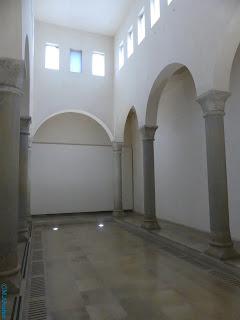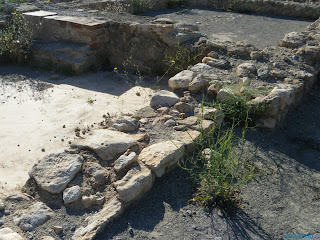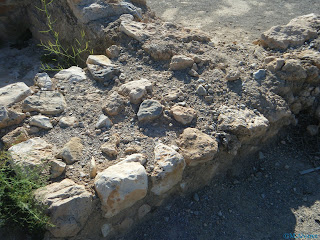Vía sepulcral romana de la plaza de la Vila
Barcelona
domingo, 4 de junio de 2017
viernes, 26 de mayo de 2017
mould
Object type
mould
Museum number
2000,0620.1
Description
Stone mould showing soles of pair of feet in relief.
Culture/period
Roman (?) term details
Findspot
Excavated/Findspot: Pompeii;
(Europe,Italy,Campania,Naples (province),Pompeii)
Materials
stone term details
Dimensions
Height: 2.4 centimetres
Length: 7.1 centimetres
Width: 6.9 centimetres
http://britishmuseum.org/research/collection_online/collection_object_details.aspx?objectId=409929&partId=1&place=35011|34970&plaA=34970-3-1|35011-3-1&sortBy=imageName&page=1
Phaedra with an attendant, probably her nurse.
Museum number
1856,0625.5
Description
Full: Front
Fragmentary wall painting: Phaedra with an attendant, probably her nurse.
© The Trustees of the British Museum
http://britishmuseum.org/research/collection_online/collection_object_details/collection_image_gallery.aspx?assetId=192092001&objectId=466195&partId=1
Furniture support: female sphinx with Hathor-style curls
Furniture support: female sphinx with Hathor-style curls
Period:Middle Bronze Age–Old Assyrian Trading ColonyDate:ca. 18th century B.C.Geography:Anatolia, probably from AcemhöyükCulture:Old Assyrian Trading ColonyMedium:Ivory (Hippopotamus), gold foilDimensions:H. 5 x W. 4 1/8 in. (12.7 x 10.4 cm)Classification:Ivory/Bone-SculptureCredit Line:Gift of George D. Pratt, 1932Accession Number:32.161.46
Around 1900 B.C., traders from the northern Mesopotamian city of Ashur established karums, or "merchants' colonies," at a number of central Anatolian cities, among them the site of Acemhöyük. Assyrian merchants lived in a restricted area of these cities, trading textiles and tin from the southeast for silver but operating under the rule of local kings. Acemhöyük is a large mound located south of Ankara near the Turkish town of Aksaray on the Konya Plain. It lay on a route linking Anatolia and the East and seems to have been an important center for the copper trade and industry. In 1965 a Turkish archaeological expedition found sealed bullae, inscribed clay tablets, ivories, and other objects outside the karum of Acemhöyük in two burned palaces on the highest part of the mound.
A group of ivories given to the Museum in the 1930s is thought to have come from Acemhöyük because of close similarities in style and subject to those known to have been found there. Ranging in color from white to gray-blue and a pinkish orange, they have been warped and discolored by fire and soil conditions. They were carved to represent the fantastic composite creatures important in the mythology of the ancient Near East. This small female sphinx is a form borrowed from the Egyptians. Her large almond-shaped eyes and spiral locks ultimately derive from the Egyptian goddess Hathor. As with the later ivories from Nimrud, this sphinx, one of four in the Museum, was carved as furniture decoration.
mermuseum.org
jueves, 18 de mayo de 2017
Relief of Clapping Women
Relief of Clapping Women
- Period:
- Middle Kingdom
- Dynasty:
- Dynasty 11
- Reign:
- Mentuhotep II
- Date:
- ca. 2051-2000 B.C.
- Geography:
- From Egypt, Deir el-Bahri, Tomb of Neferu
- Medium:
- Limestone, paint
- Dimensions:
- H. 31.7 cm (12 1/2 in.); W. 27.9 cm (11 in.); D. 1.2 (1/2 in.)
- Credit Line:
- Cincinnati Art Museum, Gift of Joan L. Stark in memory of Louise J. Roth, 1998.54
- metmuseum.org
Los baños del almirante
Los baños del almirante
Edificio mudéjar que se sitúa junto al Palacio de los Almirantes de Aragón, en el centro histórico de Valencia. Fueron construidos entre... 1313 y 1320 por Pere de Vilarasa, caballero y jurista durante el reinado de Jaime II. A pesar de haber sido construidos ya en época cristiana, son unos baños similares a los baños de vapor o hammam típicamente característicos de la arquitectura islámica, por lo que el conjunto debe de enclavarse dentro de la arquitectura mudéjar valenciana. Fueron construidos en el siglo XIV y fueron utilizados hasta el siglo XX.
Edificio mudéjar que se sitúa junto al Palacio de los Almirantes de Aragón, en el centro histórico de Valencia. Fueron construidos entre... 1313 y 1320 por Pere de Vilarasa, caballero y jurista durante el reinado de Jaime II. A pesar de haber sido construidos ya en época cristiana, son unos baños similares a los baños de vapor o hammam típicamente característicos de la arquitectura islámica, por lo que el conjunto debe de enclavarse dentro de la arquitectura mudéjar valenciana. Fueron construidos en el siglo XIV y fueron utilizados hasta el siglo XX.
miércoles, 17 de mayo de 2017
Suscribirse a:
Entradas (Atom)






















































